Selcouth Chronicles Week 17
Hello family and friends! Welcome to week 17 of the Selcouth Chronicles.
Week 17: April 28 - May 4
April 30 🛫Thessaloniki -> 🛬Athens🛫 ->🛬 Rome
May 3 Rome🚶->Vatican City🚶->Rome
May 4 🚗 Rome ->Civita di Bagnoregio🚗-> Orvieto
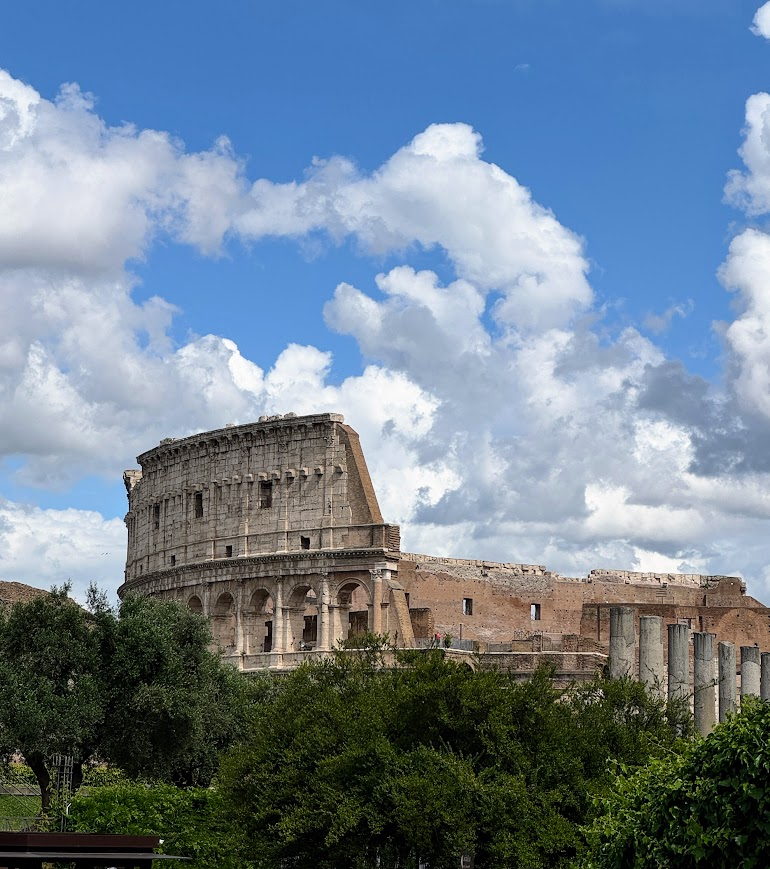
GREECE & ITALY
Highlights: Ikos Resort, E-bike rentals, Colosseum, Pantheon, Roman Forum, Palatine Hill, Vatican Museums, Sistine Chapel, Trevi Fountain, exploring the streets of Rome, Italian pizzas
Sean:
This week we closed out Greece at the resort and made our way to Italy. The first few days didn’t have much more than relaxing and eating, which was welcome after three months of being on the move. That doesn’t mean there’s nothing to write about though!
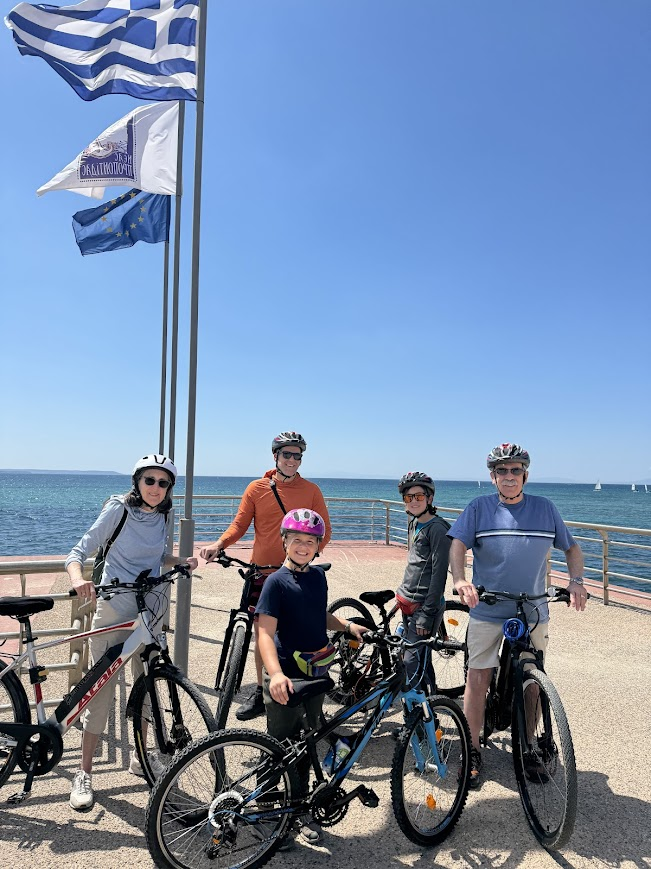
On Sunday we decided to take advantage of the resort allowing you to check out bicycles for the day to ride into the nearby town, Nea Moudania. After breakfast we walked over to get the bikes and discovered that they actually have electric bikes in addition to their regular bikes. Well, e-bikes for adults, not for the kids (sorry Abby and James!). It’s a fairly short ride into the city, only 10-15 minutes, as long as traffic is cooperating. We looked around the city a bit, rode back and across to the other side of the resort, then decided that was enough activity and spent the rest of the day poolside. For dinner we went to the Asian restaurant, Anaya. The food was good, but the big surprise was the birthday cake. Caitlin had snuck off and explained that I’d wanted to come to the resort for my 40th birthday but was unable to, so they decided to treat it like my belated birthday. It was unexpected and very appreciated. The cake was delicious too!
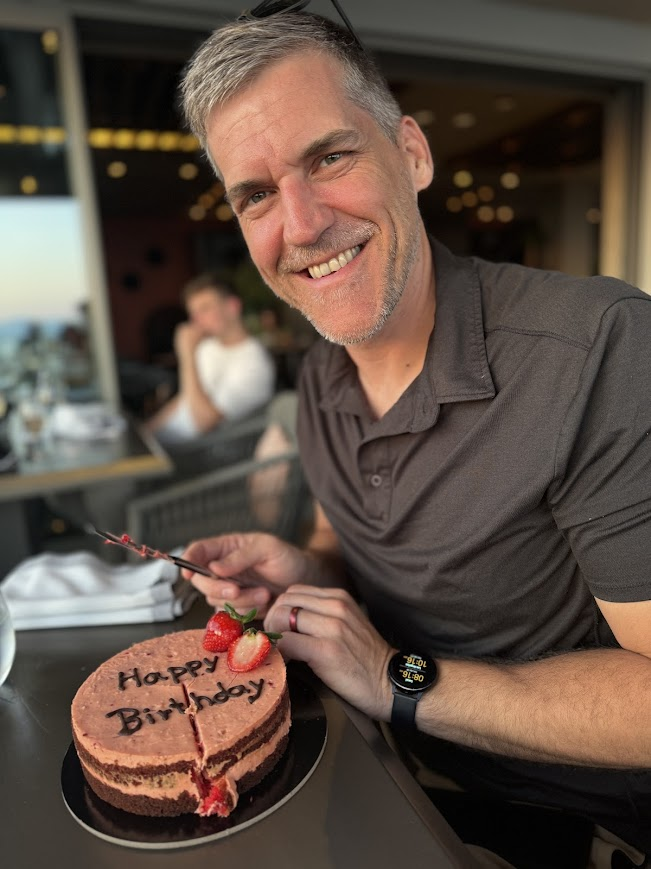
Monday was our last full day at the resort, so it was a mix of relaxing by the pool, packing up, and working on the newsletter. A highlight of the day for me was playing chess on the lifesize chess board in the resort with James, and we did get one last dinner at the Italian restaurant that we all agreed was the best. Abby ordered two helpings of their ravioli to make sure she got enough!
It was back to traveling on Tuesday, as we made our way to the Thessaloniki airport to transfer to Athens and complete our journey to Rome. Once there we caught an Uber to the Airbnb, which was located inside the Campo de’ Fiori, a small square filled with shops, restaurants, and a market every morning. It was a bit complicated to figure out how to get to the Airbnb as it’s in the middle of the square, and pedestrians walk through it, but we eventually sorted it out. By the time we were settled into the place, it was already pretty late, so we decided to just go downstairs and eat at a restaurant recommended by the host.It was literally right at the bottom of the stairs to the building. It was fun people-watching in the square while we ate pizza.
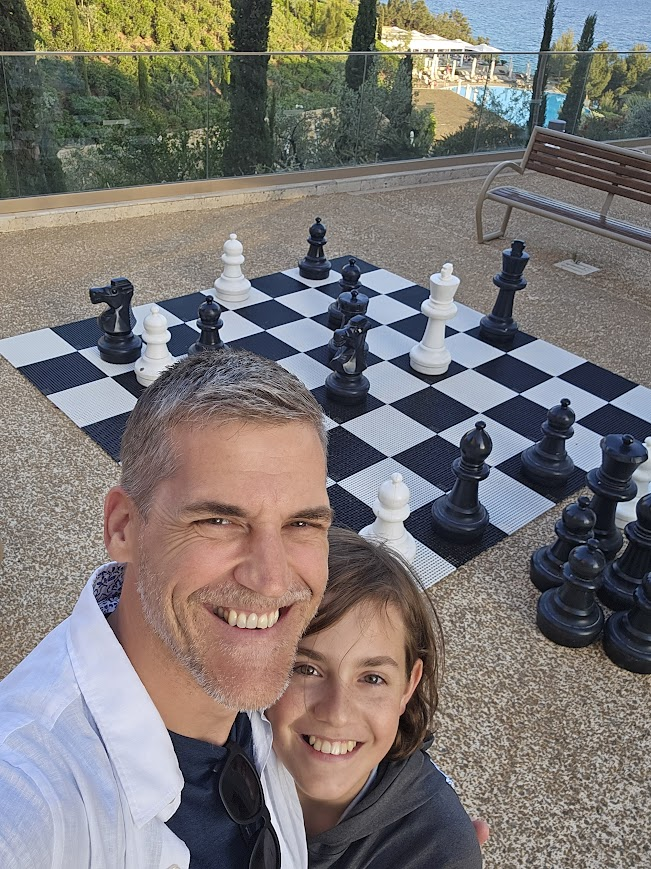
Bright and early the next morning (thanks one hour time shift!), Liz and I made our way out to get some supplies from the supermarket. This turned out to be much more interesting than intended, as the market nearest to the Airbnb turned us away twice before they finally finished opening. It was a reminder of the much more relaxed approach they take here to things like opening and closing times. It was an opportunity to explore a bit of Rome while we tried to find another market. Once that was done, we made a trip to a patisserie, loaded up on pastries for breakfast, and brought them back to a happy group. Later, we began winding our way towards the Colosseum while being rained on. At first it was a mild rain that we could handle without too much trouble, but almost as if Jupiter/Zeus himself was trying to keep us away, the rain began coming sideways in a full-on downpour. Our tickets were rain or shine, so we ducked our heads under our umbrellas and rain jackets and pushed on. Luckily, there were some long breaks in the rain while we were in the Colosseum, so we got to see some of it without squinting through the rain, but we all agreed we hadn’t been that wet in a long time. We took an uber back to the Airbnb (we were done with walking at that point) and made a delicious pasta in the kitchen. Caitlin tried multiple times to purchase Pantheon tickets, finally getting them to take our money, but the tickets never arrived!
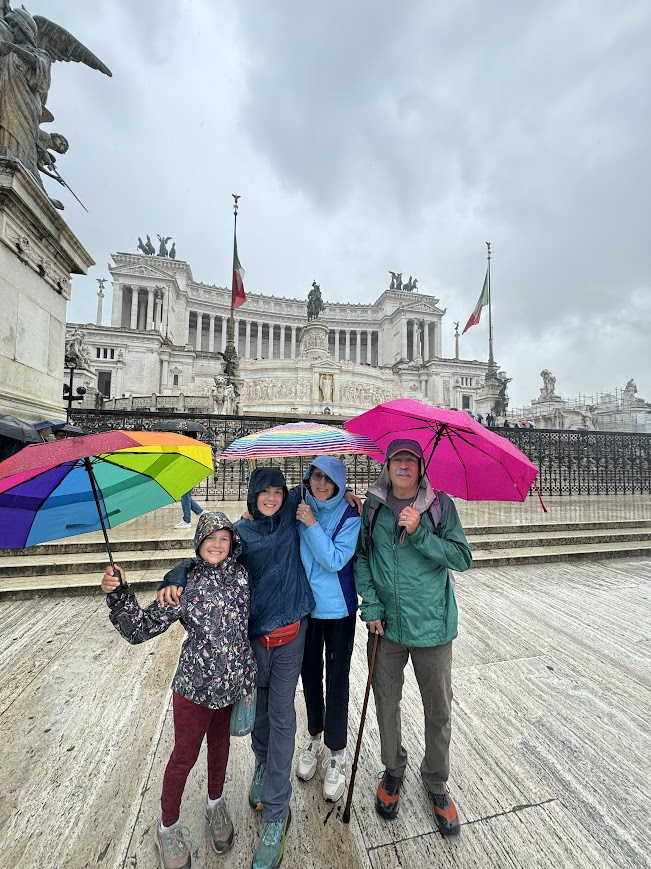
Thursday morning, when the tickets still were not in our inbox, we decided that Caitlin and I would go before the ticket desk was open and try to sort things out. We stood outside the Pantheon, chatting with some other tourists while waiting for them to let us in. The rest of the group joined us just before they opened up, and we made our way in. After explaining to the person at the counter that they’d charged us but not issued us tickets (and showing receipts), she eventually just let us through. We listened to Rick Steves’ audio guide about the Pantheon and slowly wandered the building, marveling at the wonder that its construction represented. Since we’d rushed out the door to get to the ticket office, we had a late breakfast at a local cafe, just as we started to get rained on again! After eating, we decided that we should shelter from the rain a bit, so we went back to Airbnb so the kids could do some math and Caitlin and I could do some much needed trip planning. Once we thought the storm had passed, we made our way to the Roman Forum. This was the heart of Rome at its peak, and though it is largely rubble, you can picture what it might have been like when the triumphant emperors back in the day would ride down the road with the spoils of conquest. The highlight for me may have been the Temple of Julius Caesar, which without the audioguide I would have walked right past due to its nondescript nature. Here was the spot where Julius Caesar’s body was burned after his assassination, and to this day, flowers are placed on the spot by those that appreciate all he did for Rome. The Rick Steves audio guide for the location said that it is rumored that so many Romans threw fuel onto the funeral pyre as a show of respect for Caesar that the fire department had to be called to control it. Afterward, the site was made into a temple, the first time an emperor was promoted to a god after death. The night was capped off with dinner at a place making pasta in the window and it was delicious.
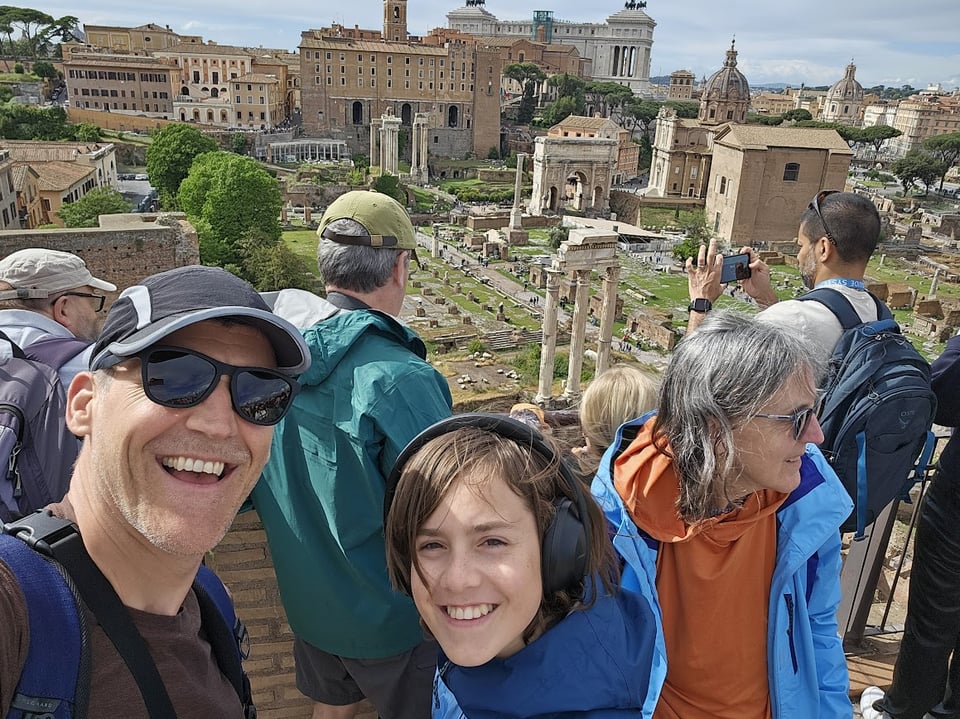
Our final full day in Rome revolved around our trip to Vatican City. After a stop at a patisserie for breakfast, we made the walk across the river to the smallest city-state in the world. The tickets we purchased included a guide, so we followed her through the maze of museums, apartments, and gardens that make up the Vatican City. There was a lot of interesting information shared by our guide that made the tour much more interesting. It was a two-hour long walk, so not a small feat. After the tour, we were able to enter the Sistine Chapel, which is my second time being inside. We listened to yet another Rick Steves audio guide for the chapel, and stood in awe of what may be the most impressive collection of artwork by one individual anywhere in the world. Once that was done, we hightailed it (with another gelato stop) back across the river to the Trevi Fountain. For those unaware, there is a myth that if you throw a coin into the fountain with your right hand over your left shoulder, it guarantees your return to Rome. Caitlin did this last time she was here, so empirical evidence currently supports the theory. All of us threw another coin in, so perhaps there’s another Rome trip in the future for the Samenfeld-Specht family. After a quick pizza dinner, James and I broke off from the group to make a quick trip to the Spanish Steps, which others had seen on previous trips.
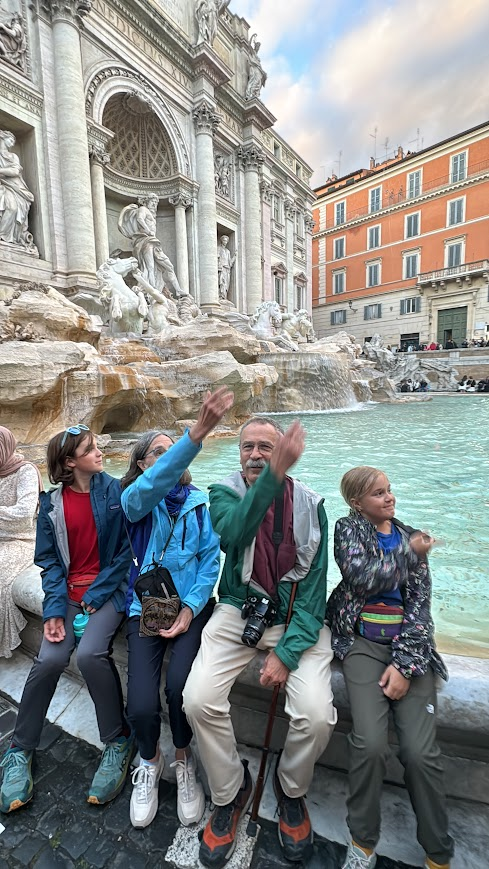
The next day was all about repacking, getting out the door, and making our way to the airport to pick up the rental cars. Our Uber driver was very helpful with some driving tips, and as expected, it took us way too long to get our cars and get on the road. We finally made the journey out of Rome. Our next destination was Orvieto, but we wanted to make a short stop in a small town called Civita di Bagnoregio on the way. It’s a place where currently only eleven people live full time, and is sometimes referred to as Italy’s dying city. This is because many believe it will collapse, due to the fact that it’s built on a spire of tufa limestone. That’s right, it’s a collection of a few buildings, only accessible by bridge, on top of a plateau of limestone. It’s truly an incredible and unique place. As expected, once you make your way across the bridge, there isn’t a whole lot to see, but still a fun place to say you have visited. Unfortunately, Jim wasn’t feeling well by that point and ended up going to the hospital for some tests. Liz and Caitlin followed along, so I took the kids onward to our final destination for the day. The kids and I got settled, found a place to eat (after three tries!), got some gelato, and waited to see what was next. Luckily, the tests all came out looking okay, so Jim, Liz, and Caitlin made their way to Orvieto, albeit well past one in the morning. Hopefully, our time in Orvieto is as wonderful as our memories are from our original trip here more than nine years ago.
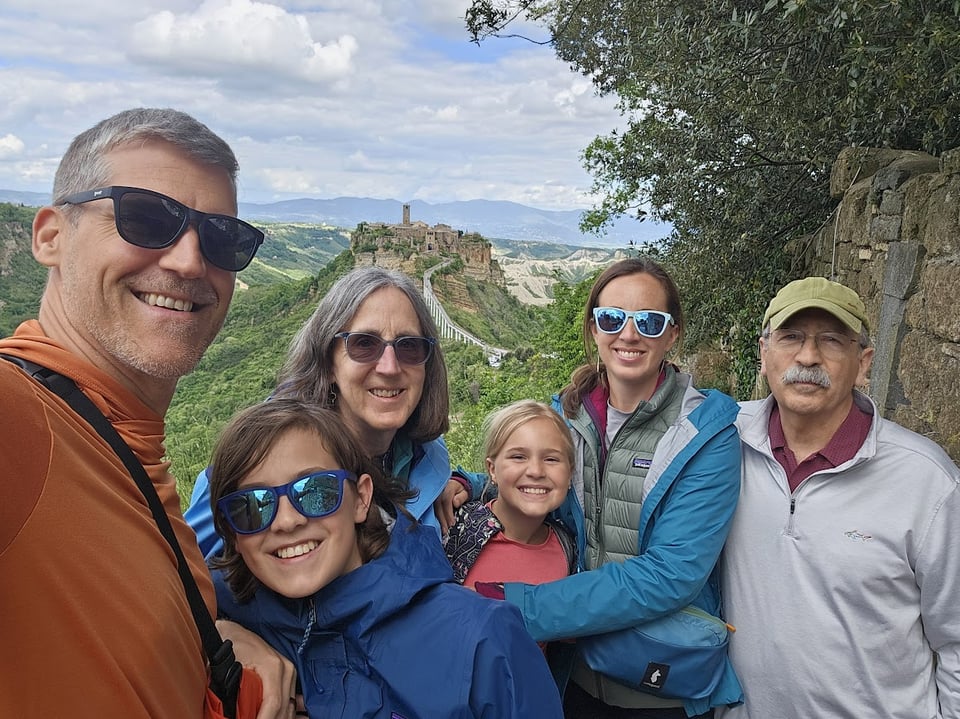
James:
We all love watching sports. Seeing your favorite team play, whether they win or lose, always gives you a thrill. This feeling was the same a millennia ago, though the things they did were a little different. Instead of people tossing around a boring old ball, they preferred to watch them kill each other in gladiatorial combat. In ancient Rome, they found it so entertaining that their government built a massive stadium dedicated to the sport. It was called the Colosseum, and most of it is still standing today. The structure is 189 meters long and 156 meters wide, and made primarily of travertine, tuff, and brick-faced concrete. It was a smash hit, with fans filling every seat, and even sometimes sitting on things that weren’t seats, like its balconies. The balconies were extremely high up and not a great place to sit, so the stadium ended up responsible for a couple hundred deaths a year thanks to not-careful spectators. The people in charge didn’t bother to do anything about it, either. People today are a lot more careful, and when I arrived they had installed safety railings and walking paths for tourists like me. Personally, I thought that it made the experience less exciting, but “safety first,” I suppose. 😆
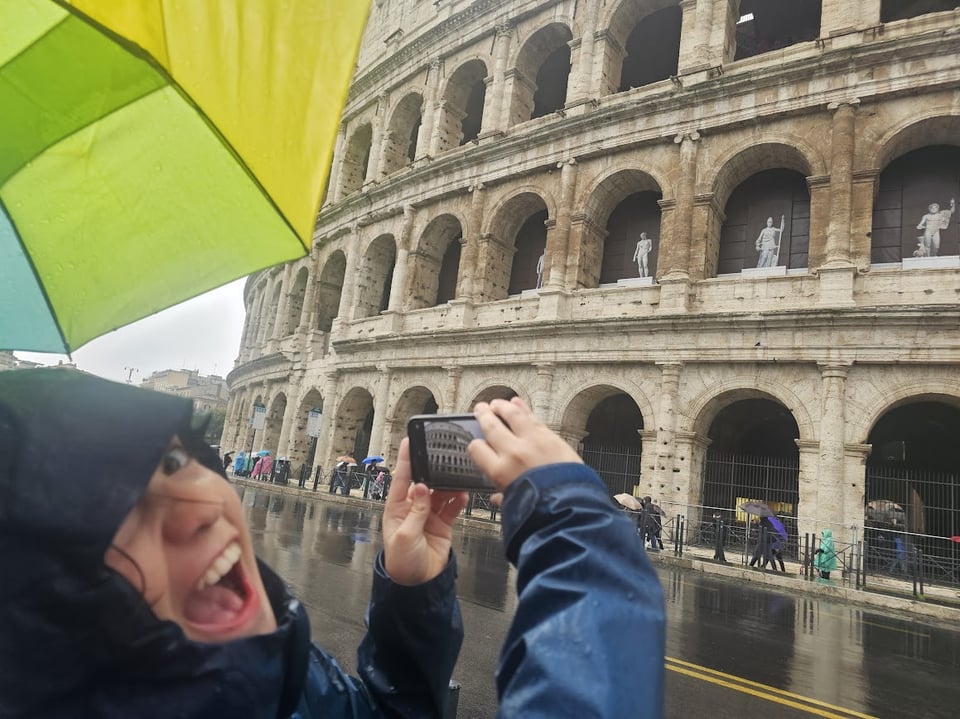
Today, a good portion of the Colosseum has fallen to time and nature. Half the floor is gone, allowing viewers to see straight down into the underground tunnels. They once functioned as the building’s backstage, and even had pulley systems to lift people out of the ground. Those pulley systems were one of the very first versions of onstage trapdoors. It was really cool to look at! People can also go down into the tunnels and have fun pretending to be Roman backstage crew or gladiators preparing for battle. Upstairs, the walkways are pretty high up, so you can see down to the Colosseum floor through the huge archways. I normally only see photos of the Colosseum from the outside, and seeing the inside in person was awe-inspiring.
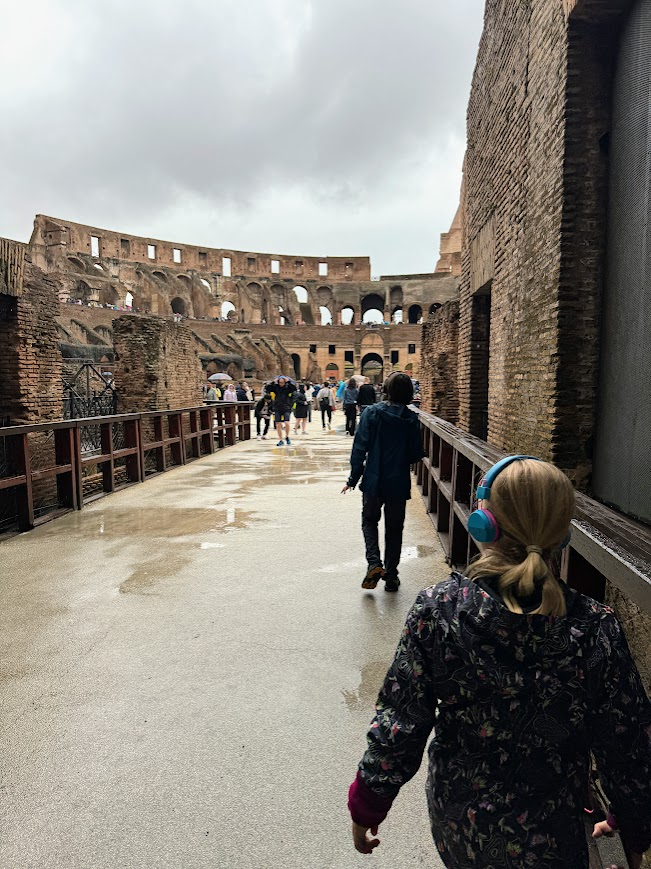
Our audioguide was very informative and helped us understand everything we were seeing and the history of the building. I don’t have enough space in the newsletter to share the full history of the Colosseum, but I will say that it is fascinating! I have wanted to visit Rome for a long time and touring the Colosseum was a definite highlight for me. I loved every minute of being there.
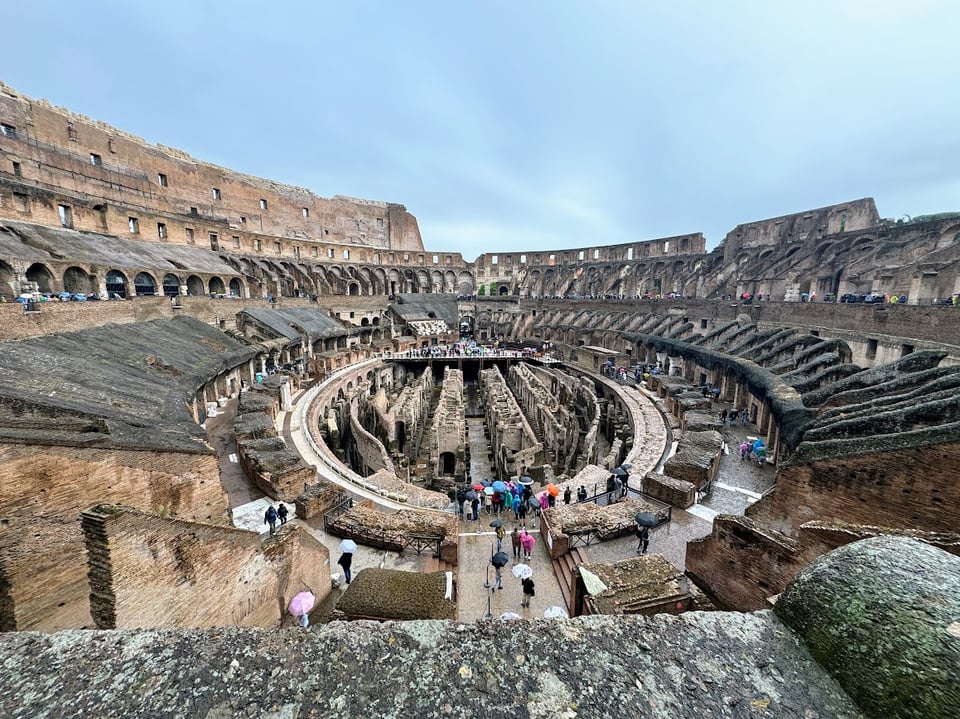
Abby:
This week we visited the world’s smallest independent state, Vatican City. It is located inside Rome, but is qualified as a city-state - kind of like Singapore! It’s the center of the Catholic religion and has a very interesting history. We went there to see the Vatican Museums and the Sistine Chapel. Michelangelo’s paintings are definitely the main attraction of the chapel, and I think they are the best part of the story.
These widely known paintings are done by the one and only Michelangelo. The walls of the Sistine Chapel are huge, so it understandably took him about four years to paint the whole thing. Pope Julius II ordered Michelangelo to paint the walls of the Chapel in 1508. At first, Michelangelo refused because he didn't consider himself good enough for the job. Our tour guide told us that he thought of himself as a sculptor and an architect more than a painter. Michelangelo sent a letter back to the Pope saying that he was very busy in Florence and he could not come to paint the chapel. The Pope was not very happy about this, so next time he sent his guards to Florence as a sort of threat to get Michelangelo to agree. You can't refuse the Pope! Michelangelo decided to make the journey to Vatican City. There, he started the hard work of painting the ceiling of the Sistine Chapel.
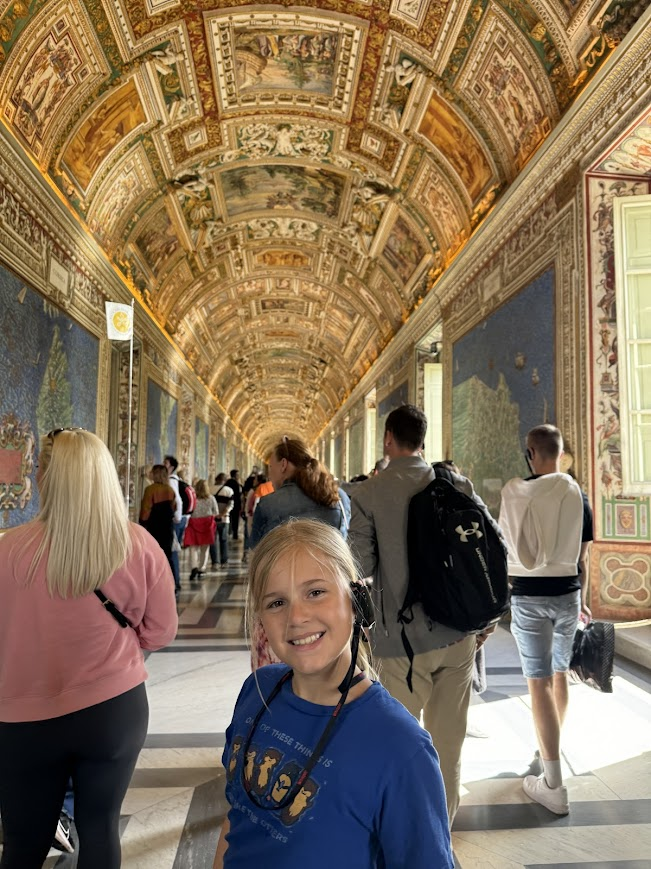
Many people say that Michelangelo painted the ceiling laying down on scaffolding. The truth is that unlike many other painters, Michelangelo decided to paint standing up looking at the ceiling while he painted. Unfortunately, everybody knows that if you look up and hold your arms above you for too long it can get very tiring and painful for your arms and neck. The ceiling was so big that four years of doing this nonstop crippled Michelangelo's body forever. Plus all that paint dripping in his eyes caused him, by the end, to be almost completely blind. Obviously, Michelangelo was not very happy about this. He went back to Florence and kept working until 24 years later, when he was called back by another Pope to paint the altar wall. On that wall, he painted a work called The Last Judgment, which took him about four more years.
The ceiling of the Sistine Chapel is the largest single work of art in the world. Some parts of it, like the Creation of Adam, have become some of the most well-known religious paintings in history. It is so cool to see paintings in person that you have been staring at all your life. Even though Michaelangelo didn’t think that he was worthy of the job, I think he was an extremely gifted painter.
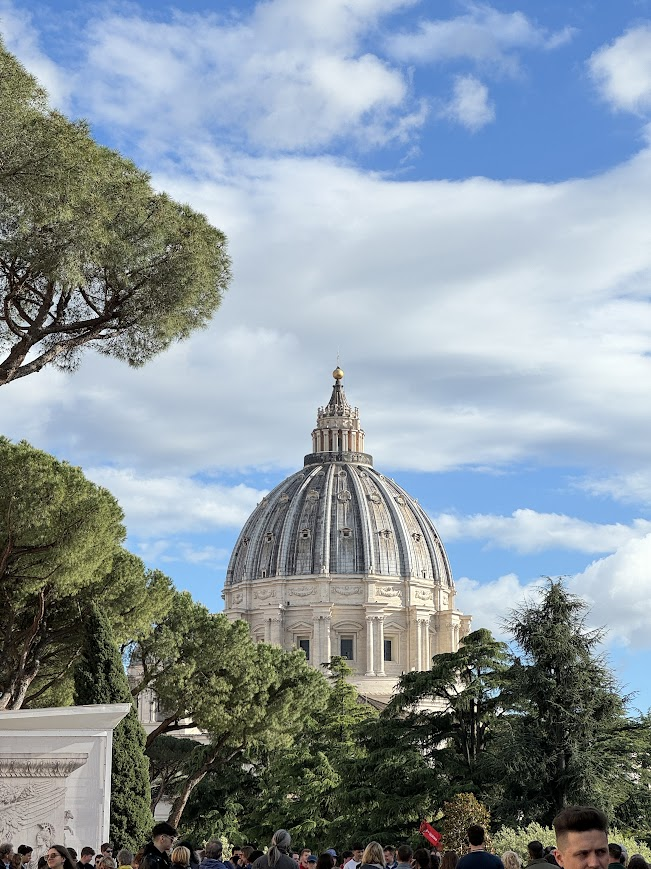
Caitlin:
I was not excited to visit Rome. I was there once before, and my memory of it was that it was my least favorite place in Italy. I was near the end of my year abroad in college, money was extremely tight, and it felt more crowded and less impressive than I had hoped. Still, the city is full of things to see and on this trip we’ve been learning a lot about how the Roman empire has affected history throughout the world, so we felt like it was important for the kids to see the main sites of the city. Plus James was very excited to see Rome after learning about it in Social Studies class. Plus Rome is the easiest airport for connecting from Greece, and a good starting point for the other cities we want to visit. I reluctantly added three days in Rome to our itinerary.
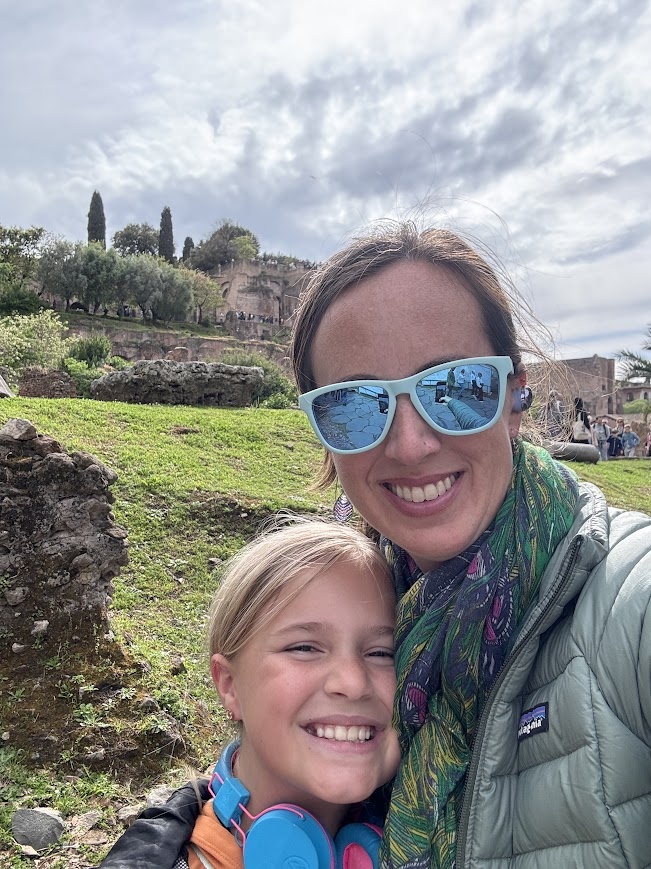
Luckily, this time around my impression of Rome was totally different. I have to acknowledge that much of the changed experience was due to finances. Instead of a hostel at the edge of the city, we stayed in an apartment in a popular central piazza. Instead of skirting the outside of monuments that I couldn’t afford tickets to in college, we were able to book advance tickets to most of the popular sites. It was a totally different feeling. I loved being able to see the Colosseum from the inside, though as luck would have it, both times I have visited I got rained on! The Roman Forum and Palatine hill were infinitely more interesting to walk through than to view from the edges. When I was last in Rome it was a few days after the death of Pope John Paul II, and most of Vatican City was shut down while the papal conclave was convened to choose a new leader. This time, I was finally able to visit the Sistine Chapel, and was awed by the variety of artists represented in the collections of the Vatican Museums. We barely scratched the surface of what there was to see at the museums, but beyond the expected works from Michelangelo and Raphael we saw pieces by Chagall, Matisse, Klee, Kandinsky, Picasso, Rodin, Van Gogh (his only known religious work), Dali, Diego Rivera, and Gaugin, to name a few. It was an amazing variety of work that you’d never find anywhere else in the world.
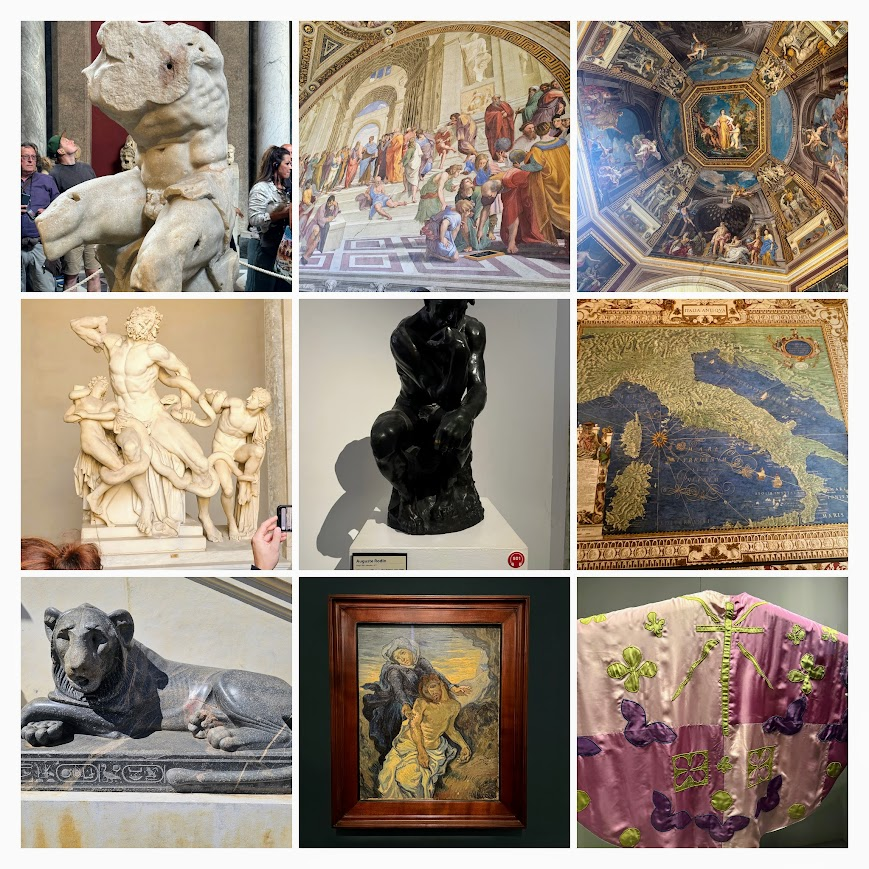
We also saw the Pantheon, which is a place I remember vividly from my first visit, not least because of a winding search to find the spot. Thank you internet for making navigation easier in the last 20 years! As with most places we visited back then, we were only able to see the outside. This time, our family was able to get tickets to see the interior, and thanks to a handy audioguide we had downloaded we were able to decipher the main features of the building. The Pantheon is the oldest standing building in Rome, built in the early 100s CE. It was saved from much of the vandalism and pillaging that other buildings of its era were later subjected to thanks to its conversion from a temple to a Christian church in the early 7th century. It is still used as a church today.
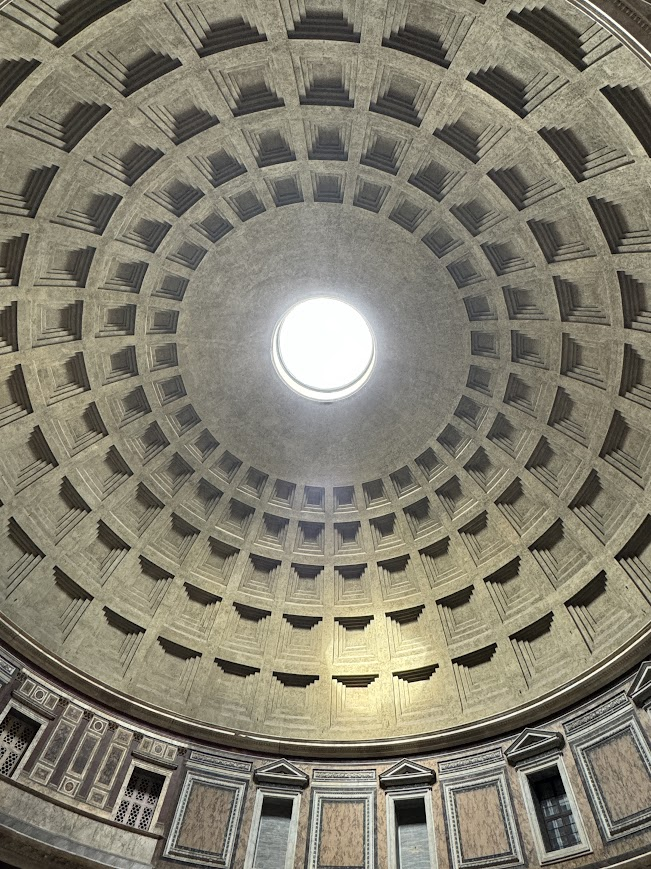
Though the history of the building is very interesting, I felt that the architecture itself was even more so. Seeing the dome from underneath was particularly lovely. The Pantheon boasts the largest unsupported concrete dome in the world; it is larger even than St. Peter’s Basilica. It is awe-inspiring to look at, and while we were there a light rain was filtering in through the open oculus at the top, creating a sparkling mist. A slight slope and strategically placed small holes in the floor prevent water from doing damage to the foundation. It is a marvel of mathematics and engineering, all the more so when you consider the tools available to architects and construction workers in 126 CE. I’m so glad that we made the trip back to Rome and I can better appreciate the gifts of the city.
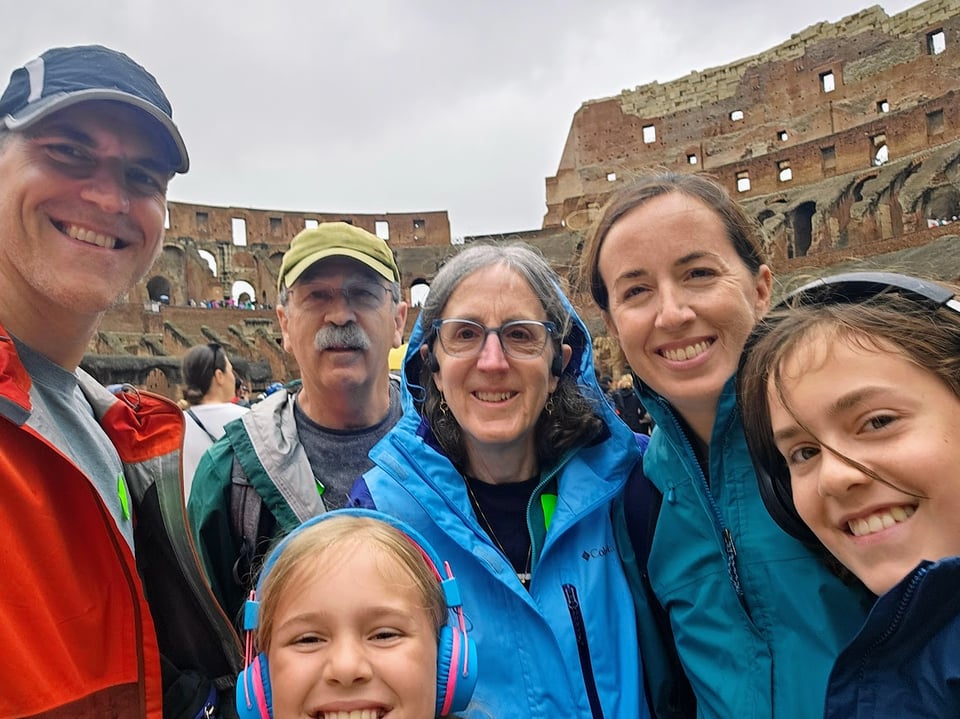
See you next week!
Sean, Caitlin, James, and Abby
Catching up? Read week 1, 2, 3, 4, 5, 6, 7, 8, 9, 10, 11, 12, 13, 14, 15, or 16.